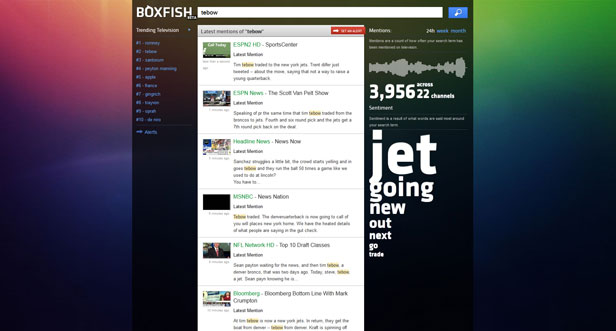Searching the Small Screen

A search engine like Google or Bing can help you find lots of things on the Web, from the mating habits of seahorses to driving directions. But what if you want to know, say, the last time Beyonce was mentioned on TV?
A new search startup called Boxfish can help. The company opened up its site in a public beta testing phase in late March, allowing users to search through words and phrases used on the TV within the past month, see the topics that are trending on TV, and set up alerts for broadcast mentions of specific terms like “Lady Gaga” or “lottery.”
Boxfish was created by Eoin Dowling and Kevin Burkitt, Ireland natives now based in Palo Alto, California, who sold a mobile entertainment startup called Red Circle to Zamano, a Web and mobile company, in 2007.
When Dowling lived in London a few years ago, he came up with the idea for Boxfish as a result of watching TV with his mother—her poor hearing meant that when she visited him, they had to watch TV with the subtitles on. “I was sitting there and this idea came to me: All these words are references to what’s happening right now. I wonder what TV would look like if it were just text streaming through the airwaves?” he says.
This was in late 2010, and Dowling and Burkitt spent the next year building Boxfish. Essentially, it captures broadcast TV through antennas and cable boxes that are connected to servers, pulls out the closed-captioning data, and indexes the dialogue in real time so it can be instantly searched.
Currently, Boxfish is indexing dialogue from channels in the U.S., U.K., and Ireland. Dowling says this includes “pretty much everything you get in your Comcast subscription,” which essentially means major channels and some local affiliates as well. Boxfish plans to add Australia and Canada soon, but its biggest focus is the U.S. market, Dowling says, and the company hopes to capture text from all local affiliate stations here.
With the 2012 presidential election coming up, Dowling expected people to use Boxfish to search for mentions of political figures like Barack Obama and Rick Santorum. Instead, he says, users tend to be looking for the latest dish on celebrities like Kim Kardashian and Lady Gaga. Dowling isn’t fazed by this, however; he’s excited that people are trying out the site, even though there aren’t many of them (he won’t say how many). Traffic will have to climb for Boxfish’s initial business model to succeed: Dowling says they plan to show ads based on visitors’ searches, a la Google.
The site is simple to use. If you search for, say, “cookie,” you’ll receive a list of results posted in chronological order along with a bit of the transcript in which the word appeared. On the right side of the screen you can see how many times it has been used recently, on how many channels, and also the words most commonly used in the same context. Click on a search result and you’ll see a big chunk of the transcript with bold text indicating the section that includes the search term.
However, Boxfish has work to do to make the service more polished. Reading the transcripts can be confusing, since they contain both show and commercial dialogue, which may appear as one long, Joycean string. The aforementioned search for “cookie” yielded, among other things, “Male Announcer: Yes, Quaker’s finally making cookies. They’re delicious, and made with the whole-grain goodness of Quaker oats. Pooches and puppies, we are fed up with being fed on. We demand K9 Advantix II. It not only kills fleas and ticks, it repels most ticks before they can attach and snack on us.”
Dowling says Boxfish plans to clarify who is saying what in the search results, and it’s also working on recognizing the difference between a commercial and a show.
But one thing Boxfish isn’t doing, at least for the time being, is letting visitors watch videos. Dowling says that Boxfish is talking with broadcasters and wants to work with them in the long term, but currently they’d be violating copyright rules if they posted episodes or snippets of shows along with search results.
Suranga Chandratillake, founder and CEO of blinkx, which allows people to search and watch online videos, sees this as a huge disadvantage. While he says Boxfish looks interesting, most people don’t just want to search dialogue, he says. They also want to watch the video in which it originated.
“If you can’t watch it, I think the primary reason people will be searching for it goes away,” he says.
Regardless, Dowling is confident that TV dialogue represents a whole other stream of data that nobody has previously recorded in a meaningful way, and he hopes consumers will want to use it.
“We just want to capture TV and allow people to do with it what they will,” he says.
Keep Reading
Most Popular
Large language models can do jaw-dropping things. But nobody knows exactly why.
And that's a problem. Figuring it out is one of the biggest scientific puzzles of our time and a crucial step towards controlling more powerful future models.
How scientists traced a mysterious covid case back to six toilets
When wastewater surveillance turns into a hunt for a single infected individual, the ethics get tricky.
The problem with plug-in hybrids? Their drivers.
Plug-in hybrids are often sold as a transition to EVs, but new data from Europe shows we’re still underestimating the emissions they produce.
Google DeepMind’s new generative model makes Super Mario–like games from scratch
Genie learns how to control games by watching hours and hours of video. It could help train next-gen robots too.
Stay connected
Get the latest updates from
MIT Technology Review
Discover special offers, top stories, upcoming events, and more.